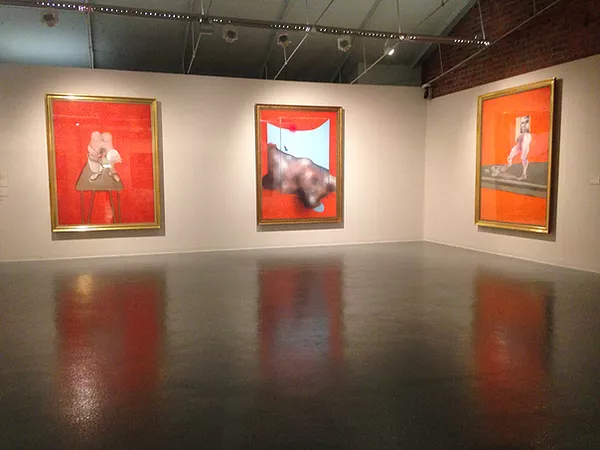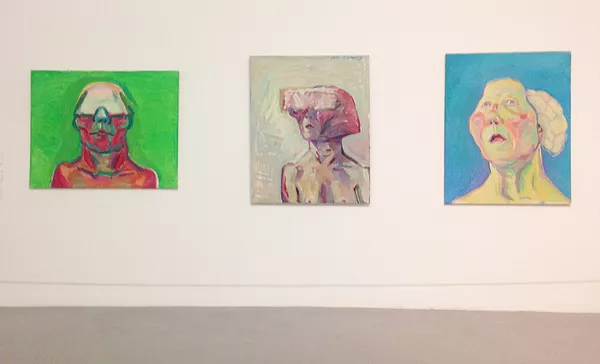June 10th 2k16, Gabrielle de la Puente and Michael Lacey
Gab would not have even bothered with the Tate Liverpool show but Michael told her that it was like an art exhibition but also like a horse parade or a crashed spaceship, or there were dinosaurs at the Albert Dock - !, she went, and it was like an arrival, an encounter, something measured and slow like volume * so they came to write together, there between Francis Bacon and Maria Lassnig in Tate Liverpool’s bizarre 2 for 1 shoulder-to-shoulder format. Words and words between these paintings and their painters, together they wrote that:
Drawing and painting make your practice and your subconscious hold hands, clammy, soft. It gives your practice the feeling of a strong tree with deep roots and magical powers. I had a chemistry teacher who was hyper-religious and quite intent on converting me. One of his favourite pieces of ‘advice’ for getting born again was almost word-for-word that Picasso thing about learning to become a child again. I once saw that teacher lying on the floor of the school chapel speaking in tongues and waving a flag above his head, and while I remain godless, I think he would have made a good painter. Painters are shamanic, holy characters, and also childish. Maybe Francis Bacon was that outlier kid in class, the subject of weird rumours - lives at a dog track, eats sand, his dad's a ghost. I am thinking again of a specific person from school who also would have made a good painter.
I’m thinking: these painters are so sensitive to medium they reach formal sincerity. Sand feels good against their teeth. Formal sincerity is Bacon’s mythology, which is more meaningful than the tedious ongoing fascination with his studio (apparently it was a mess).
Formal sincerity is his mythology because his method is so pure - always painting, never illustrating or rehearsing. He's thinking directly onto the canvas, and it makes the room in the air heavy - gives conviction to provenance, mysticism to images inside gold frames and glass. In the contorted figures and howling faces smudged against shadows are grinding, everyday torments elevated to stations of the cross. The room has the solemn aura of a cathedral but the smell of rotten fruit and shagging. It is Dante's Soho.
(((A small display of fragments of studio ephemera (painted-over photographs, sketchbooks) puncture the lie about never pre-sketching a painting, but it doesn't matter. For a painter or any artist to be a self-mythologising liar is no surprise and they reveal little that isn't nakedly displayed on the canvasses.)))
Maria Lassnig might have kept ants in a clear plastic pencil case. She might have sworn she saw the class’s pregnant goldfish give birth, turn around in its tank, and bite the head off its newborn gold baby; or that a deer visits her garden at night. Her formal sincerity promise is different, because where Bacon absorbs his subject through pores, in veins, it’s like Lassnig just licks and sticks hers to the side of her head. The subject slips down from her temples, and like that she stretches paint towards an image. Her neon pallet suggests primary school poster paint, I picture her with one of her Dad's shirts on backwards as she paints (on the canvas, on the floor, on her hands). I think about how slugs go on leaving themselves everywhere. Her paintings are ugly in a tender and pathetic way, an out-of-tune violin to the Wagnerian sturm-und-drang of Bacon's compositions. They're inconsistent, restless - shedding aesthetics like snakeskin. / she alone held me for an hour, and during, I thought about how I am always in a good mood when I’m hungover (and hyper aware of texture, dragging my fingers along everything as I walk)/ I thought about how kangaroos seem so made up/ I decided the lower back is the strangest part of the body, and my favourite curl in space. Like the Chris Kraus of painters, Lassnig rolls her eyes as practice, and I loved her in this free way.
*
I think: this exhibition is like laying yourself down for a while but not quite being able to sleep. Inner-turmoily, the paintings are true even as they are fiction and suggestion, like: you might get real with yourself if you try, but do you even want to? Is someone knocking at the window? What time is it? Eventually you'll have a nightmare but at the moment it's just dark. It’s slow, and it’s a confident kind of sad. And this 2 for 1 format at Tate Liverpool has pissed me off in the past, because it’s like your mum making you taste something she’s convinced you’ll like, an institution telling you to eat your greens - but I actually enjoyed Bacon with Lassnig. Close but not touching, they make sense together, like Lassnig’s work is the bed-hole moment you pull yourself together and admit sleep isn’t going to happen; and then lucid, Bacon paints the concession in movement as you rip yourself away from the sheets.


